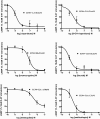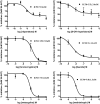Pharmacological analysis of the novel, rapid, and potent inactivation of the human 5-Hydroxytryptamine7 receptor by risperidone, 9-OH-Risperidone, and other inactivating antagonists
- PMID: 18996971
- PMCID: PMC2671286
- DOI: 10.1124/mol.108.052084
Pharmacological analysis of the novel, rapid, and potent inactivation of the human 5-Hydroxytryptamine7 receptor by risperidone, 9-OH-Risperidone, and other inactivating antagonists
Abstract
In a previous publication, using human 5-hydroxytryptamine(7) (h5-HT(7)) receptor-expressing human embryonic kidney (HEK) 293 cells, we reported the rapid, potent inactivation of the h5-HT(7) receptor stimulation of cAMP production by three antagonists: risperidone, 9-OH-risperidone, and methiothepin (Smith et al., 2006). To better understand the drug-receptor interaction producing the inactivation, we 1) expanded the list of inactivating drugs, 2) determined the inactivating potencies and efficacies by performing concentration-response experiments, and 3) determined the potencies and efficacies of the inactivators as irreversible binding site inhibitors. Three new drugs were found to fully inactivate the h5-HT(7) receptor: lisuride, bromocryptine, and metergoline. As inactivators, these drugs displayed potencies of 1, 80, and 321 nM, respectively. Pretreatment of 5-HT(7)-expressing HEK cells with increasing concentrations of the inactivating drugs risperidone, 9-OH-risperidone, methiothepin, lisuride, bromocriptine, and metergoline potently inhibited radiolabeling of the h5-HT(7) receptor, with IC(50) values of 9, 5.5, 152, 3, 73, and 10 nM, respectively. We were surprised to find that maximal concentrations of risperidone and 9-OH-risperidone inhibited only 50% of the radiolabeling of h5-HT(7) receptors. These results indicate that risperidone and 9-OH risperidone may be producing 5-HT(7) receptor inactivation by different mechanisms than lisuride, bromocryptine, metergoline, and methiothepin. These results are not interpretable using the conventional model of G-protein-coupled receptor function. The complex seems capable of assuming a stable inactive conformation as a result of the interaction of certain antagonists. The rapid, potent inactivation of the receptor-G-protein complex by antagonists implies a constitutive, pre-existing complex between the h5-HT(7) receptor and a G-protein.
Figures





Similar articles
-
Human 5-HT7 receptor-induced inactivation of forskolin-stimulated adenylate cyclase by risperidone, 9-OH-risperidone and other "inactivating antagonists".Mol Pharmacol. 2009 Sep;76(3):552-9. doi: 10.1124/mol.109.056283. Epub 2009 Jun 9. Mol Pharmacol. 2009. PMID: 19509219 Free PMC article.
-
Clozapine and other competitive antagonists reactivate risperidone-inactivated h5-HT7 receptors: radioligand binding and functional evidence for GPCR homodimer protomer interactions.Psychopharmacology (Berl). 2010 Dec;212(4):687-97. doi: 10.1007/s00213-010-2001-x. Epub 2010 Sep 9. Psychopharmacology (Berl). 2010. PMID: 20827463 Free PMC article.
-
Risperidone-induced inactivation and clozapine-induced reactivation of rat cortical astrocyte 5-hydroxytryptamine₇ receptors: evidence for in situ G protein-coupled receptor homodimer protomer cross-talk.Mol Pharmacol. 2011 Feb;79(2):318-25. doi: 10.1124/mol.110.069278. Epub 2010 Nov 9. Mol Pharmacol. 2011. PMID: 21062995 Free PMC article.
-
Pharmacology of 5-hydroxytryptamine-1A receptors which inhibit cAMP production in hippocampal and cortical neurons in primary culture.Mol Pharmacol. 1988 Feb;33(2):178-86. Mol Pharmacol. 1988. PMID: 2828913
-
5-HT 1B/D receptor antagonists.Gen Pharmacol. 1997 Sep;29(3):293-303. doi: 10.1016/s0306-3623(96)00460-0. Gen Pharmacol. 1997. PMID: 9378233 Review.
Cited by
-
Paliperidone for schizophrenia.Cochrane Database Syst Rev. 2008 Apr 16;2008(2):CD006369. doi: 10.1002/14651858.CD006369.pub2. Cochrane Database Syst Rev. 2008. PMID: 18425951 Free PMC article.
-
A cellular perspective of bias at G protein-coupled receptors.Protein Sci. 2020 Jun;29(6):1345-1354. doi: 10.1002/pro.3872. Epub 2020 Apr 27. Protein Sci. 2020. PMID: 32297394 Free PMC article. Review.
-
Modulation of Serotonin Receptors in Neurodevelopmental Disorders: Focus on 5-HT7 Receptor.Molecules. 2021 Jun 2;26(11):3348. doi: 10.3390/molecules26113348. Molecules. 2021. PMID: 34199418 Free PMC article. Review.
-
Human 5-HT7 receptor-induced inactivation of forskolin-stimulated adenylate cyclase by risperidone, 9-OH-risperidone and other "inactivating antagonists".Mol Pharmacol. 2009 Sep;76(3):552-9. doi: 10.1124/mol.109.056283. Epub 2009 Jun 9. Mol Pharmacol. 2009. PMID: 19509219 Free PMC article.
-
Therapeutic Potential and Limitation of Serotonin Type 7 Receptor Modulation.Int J Mol Sci. 2023 Jan 20;24(3):2070. doi: 10.3390/ijms24032070. Int J Mol Sci. 2023. PMID: 36768393 Free PMC article. Review.
References
-
- Bard JA, Zgombick J, Adham N, Vaysse P, Branchek TA, and Weinshank RL (1993) Cloning of a novel human serotonin receptor (5-HT7) positively linked to adenylate cyclase. J Biol Chem 268 23422-23426. - PubMed
-
- Bhana N and Spencer CM (2000) Risperidone: a review of its use in the management of the behavioural and psychological symptoms of dementia. Drugs Aging 16 451-471. - PubMed
-
- Borison RL, Diamond B, Pathiraja A, and Meibach RC (1994) Pharmacokinetics of risperidone in chronic schizophrenic patients. Psychopharmacol Bull 30 193-197. - PubMed
-
- Bruheim S, Krobert KA, Andressen KW, and Levy FO (2003) Unaltered agonist potency upon inducible 5-HT7a but not 5-HT4b receptor expression indicates agonist-independent association of 5-HT7a receptor and Gs. Receptors Channels 9 107-116. - PubMed
-
- Dautzenberg FM and Neysari S (2005) Irreversible binding kinetics of neuropeptide Y ligands to Y2 but not to Y1 and Y5 receptors. Pharmacology 75 21-29. - PubMed
Publication types
MeSH terms
Substances
Grants and funding
LinkOut - more resources
Full Text Sources
Other Literature Sources
Research Materials
Miscellaneous

